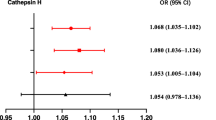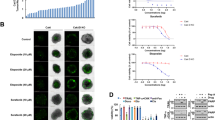Abstract
Cysteine proteinase cathepsin S (Cat S) is expressed mainly in lymphatic tissues and has been characterised as a key enzyme in major histocompatibility complex class II (MHC-II) mediated antigen presentation. Cat S has been measured in tissue cytosols of lung parenchyma, lung tumours and lymph nodes and in sera of patients with lung tumours and of healthy controls, by specific enzyme-linked immunosorbent assay (ELISA). A difference in Cat S level was found between tumour and adjacent control tissue cytosols of 60 lung cancer patients (median 4.3 vs. 2.8 ng mg–1protein). In lymph nodes obtained from 24 patients of the same group, the level of Cat S was significantly higher than in tumours or lung parenchyma (P< 0.001). Additionally, significantly higher levels were found in non-infiltrated than in infiltrated lymph nodes (median 16.6 vs 7.5 ng mg–1protein). Patients with low levels of Cat S in tumours and lung parenchyma exhibited a significantly higher risk of death than those with high levels of Cat S (P= 0.025 – tumours;P= 0.02 – parenchyma). Immunohistochemical analysis (IHA) of lung parenchyma revealed a staining reaction in alveolar type II cells, macrophages and bronchial epithelial cells. In regional lymph node tissue, strong staining of Cat S was found in lymphocytes and histiocytes. Nevertheless, Cat S was detected also in tumour cells, independently of their origin. Our results provide evidence that Cat S may be involved in malignant progression. Its role, however, differs from that of the related Cats B and L and could be associated with the immune response rather than with remodelling of extracellular matrix. © 2001 Cancer Research Campaign http://www.bjcancer.com
Similar content being viewed by others
Article PDF
Change history
16 November 2011
This paper was modified 12 months after initial publication to switch to Creative Commons licence terms, as noted at publication
References
Abel U, Berger J and Wiebelt H (1984) Critlevel. An exploratory procedure for the evaluation of quantitative prognostic factors. Methods Inf Med 23: 154–156
Avrameas S, Ternynck T and Guedson JL (1978) Coupling of enzymes to antibodies and antigens. Scand J Immunol 8: 7–23
Barna B and Deodhar SD (1975) The activity of regional nodes in the evolution of immune response to alogenetic and geneic tumors. Cancer Res 35: 920–926
Brömme D, Steinert A, Friebe S, Fittkau S, Wiederanders B and Kirschke H (1989) The specificity of bovine spleen cathepsin S: a comparison with rat liver cathepsins L and B. Biochem J 264: 475–481
Brömme D, Bonneau PR, Lachance P and Storer AC (1994) Engineering the S2 subsite specificity of human cathepsin S to a cathepsin L and cathepsin B-like specificity. J Biol Chem 269: 30238–30242
Chapman HA, Riese JR and Shi GP (1997) Emerging roles for cysteine proteinases in human biology. Ann Rev Physiol 59: 63–88
Gunčar G, Pungerčič G, Klemenčič I, Turk V and Turk D (1999) Crystal structure of MHC class II-associated p41 Ii fragment bound to cathepsin L reveals the structural basis for differentiation between cathepsins L and S. EMBO J 18: 793–803
Hermanek P and Sobin L (1987) UICC TNM classification of malignant tumors, 4th edn. Springer Verlag: Berlin
Hsu SM, Raine L and Fanger H (1981) Use of avidin-biotin peroxidase complex (ABC) in immunoperoxidase techniques: a comparison between ABC and unlabeled antibody (PAP) procedures. J Histochem Cytochem 29: 577–580
Kaplan EL and Meier P (1958) Nonparametric estimation from incomplete observation. J Am Stat Assoc 53: 457–481
Kayser K and Gabius HJ (1997) Graph theory and the entropy concept in histochemistry. Theoretical considerations, application in histopathology and the combination with receptor-specific approaches. In: Progress in Histochemistry and Cytochemistry, Graumann W, Bendayan M, Bosman FT, Heitz PU, Larsson LI, Wolfe HJ, eds Vol 32, Gustav Fisher: Sttutgart, Jena, Lubeck, Ulm
Kirschke H, Wideranders B, Brömme D and Rinne A (1998) Cathepsin S from bovine spleen: Purification, distribution, intracellular localization, and action on proteins. Biochem J 264: 467–473
Kopitar G, Dolinar M, Štrukelj B, Pungerčar J and Turk V (1996) Folding and activation of human procathepsin S from inclusion bodies produced inEscherichia coli. Eur J Biochem 236: 558–562
Kos J and Lah TT (1998) Cysteine proteinases and their endogenous inhibitors: Target proteins for prognosis, diagnosis and therapy in cancer (Review). Oncology Reports 5: 1349–1361
Kos J, Nielsen HJ, Krašovec M, Christensen IJ, Cimerman N, Stephens RW and Brünner N (1998) Prognostic values of cathepsin B and carcinoembryonic antigen in sera of patients with colorectal cancer. Clin Cancer Res 4: 1511–1516
Lemere CA, Munger JS, Shi GP, Natkin L, Haass C, Chapman HA and Selkoe DJ (1995) The lysosomal cysteine protease, cathepsin S, is increased in Alzheimer's disease and Down syndrome brain. An immunohistochemical study. Am J Pathol 146: 848–860
Lores B, Garcia-Estevez JM and Arias C (1998) Lymph nodes and human tumors (review). Int J Mol Med 1: 729–733
Manegold C and Drings P (1998) Chemoterapie des nichtkleinzelligen Lungenkarzinoms. In: Thoraxtumoren: Diagnostik-Staging-gegenwartiges Terapiekonzept, Drings P, Vogt-Moykopf I, eds pp. 310–327, Springer Verlag: Heidelberg
McGrath ME, Palmer JT, Brömme D and Somoza JR (1998) Crystal structure of human cathepsin S. Protein Science 7: 1294–1302
Morton PA, Zacheis ML, Giacoletto KS, Manning JA and Schwartz BD (1995) Delivery of nascent MHC class II invariant chain complexes to lysosomal compartments and proteolysis of invariant chain of cysteine proteases precedes peptide binding in B-lymphoblastoidic cells. J Immunol 154: 137–150
Petancheska S and Devi L (1992) Sequence analysis, tissue distribution, and expression of rat cathepsin S. J Biol Chem 267: 26038–26043
Pierre P and Mellman I (1998) Developmental regulation of invariant chain proteolysis controls MHC class II trafficking in mouse dendritic cells. Cell 93: 1135–1145
Schraube P, Kimmig B, Latz D, Flentje M and Wannenmacher M (1998) Radiotherapie des Bronchialkatzinoms. In: Thoraxtumoren: Diagnostik-Staging-gegenwartiges Terapiekonzept, Drings P, Vogt-Moykopf I, eds pp. 277–295, Springer Verlag: Heidelberg
Schweiger A, Štabuc B, Popovič T, Turk V and Kos J (1997) Enzyme-linked immunosorbent assay for the detection of total cathepsin H in human tissue cytosols and sera. J Immunol Methods 201: 165–172
Seliger B, Maeurer MJ and Ferrone S (2000) Antigen-processing machinery breakdown and tumor growth. Immunology Today 21: 455–464
Shi GP, Webb AC, Foster KE, Knoll JHM and Lemere CA (1994) Human cathepsin S: chromosomal localisation, gene structure, and tissue distribution. J Biol Chem 269: 11530–11536
Sloane BF, Moin K and Lah TT (1994) Lysosomal enzymes and their endogenous inhibitors in neoplasia. In: Biochemical and Molecular Aspects of selected Cancers, Pretlow TG, Pretlow TP eds. Pp 411–466, Academic Press: New York
Sukhova GK, Shi GP, Simon DI, Chapman HA and Libby P (1998) Expression of the elastolytic cathepsins S and K in human atheroma and regulation of their production in smooth muscle cells. J Clin Invest 102: 576–583
Turnšek T, Kregar I and Lebez D (1975) Acid sulphydril protease from calf lymph-nodes. Biochim Biophys Acta 403: 514–520
Uchiyama Y, Waguri S, Sato N, Watanabe T, Ishido K and Kominami E (1994) Review: Cell and tissue distribution of lysosomal cysteine proteinases, cathepsins B, H and L, and their biological roles. Acta Histochem Cytochem 27: 287–308
Werle B, Ebert W, Klein W and Spiess E (1995) Assessment of cathepsin L activity by use of the inhibitor CA-074 compared to cathepsin B activity in human lung tumor tissue. Biol Chem Hoppe-Seyler 376: 157–164
Werle B, Staib A, Julke B, Ebert W, Zlatoidsky P, Sekirnik A, Kos J and Spiess E (1999) Fluorimetric microassays for the determination of cathepsin L and cathepsin S activities in tissue extracts. Biol Chem 380: 1109–1116
Werle B, Kraft C, Schanzenbacher U, Lotterle H, Kayser K, Lah T, Kos J, Ebert W and Spiess E (2000) Significant association of cathepsin B and the lymphatic metastasising process. Cancer 89: 2282–2291
Wiederanders B, Bromme D, Kirschke H, Kalkkiner N and Rinne A (1991) Primary structure of bovine cathepsin S. Comparison to cathepsins L, H and B. FEBS Lett 286: 189–192
Zavašnik-Bergant T, Sekirnik A, Golouh R, Turk V and Kos J (2001) Immunochemical localisation of Cathepsin S, Cathepsin L and MHC Class II-Associated p41 isoform of invariant chain in human lymph node tissue. Biol Chem 380: 799–804
Author information
Authors and Affiliations
Rights and permissions
From twelve months after its original publication, this work is licensed under the Creative Commons Attribution-NonCommercial-Share Alike 3.0 Unported License. To view a copy of this license, visit http://creativecommons.org/licenses/by-nc-sa/3.0/
About this article
Cite this article
Kos, J., Sekirnik, A., Kopitar, G. et al. Cathepsin S in tumours, regional lymph nodes and sera of patients with lung cancer: relation to prognosis. Br J Cancer 85, 1193–1200 (2001). https://doi.org/10.1054/bjoc.2001.2057
Received:
Revised:
Accepted:
Published:
Issue date:
DOI: https://doi.org/10.1054/bjoc.2001.2057
Keywords
This article is cited by
-
Ab locks for improving the selectivity and safety of antibody drugs
Journal of Biomedical Science (2020)
-
The P2X7 purinergic receptor: a potential therapeutic target for lung cancer
Journal of Cancer Research and Clinical Oncology (2020)
-
Regulating BRCA1 protein stability by cathepsin S-mediated ubiquitin degradation
Cell Death & Differentiation (2019)
-
Z-FL-COCHO, a cathepsin S inhibitor, enhances oxaliplatin-mediated apoptosis through the induction of endoplasmic reticulum stress
Experimental & Molecular Medicine (2018)
-
Inhibition of cathepsin S confers sensitivity to methyl protodioscin in oral cancer cells via activation of p38 MAPK/JNK signaling pathways
Scientific Reports (2017)



